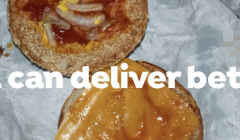
Knorr spotlights fast food fails to deliver better
The campaign from MullenLowe highlights that home made food can be better than takeaways.

Sports and fitness brands have the opportunity to push forward more inclusive marketing practises

Sports and fitness brands have pushed inclusive marketing forward, representing experiences and identities that other sectors have taken longer to address. And this shouldn’t be a surprise. When you’re in the business of progress you have the perfect platform to launch the kind of spine-tingling campaigns that make audiences actually enjoy adverts. You’re playing in a highly emotionally-charged territory that’s overflowing with cultural and social relevance. Whether you’re hawking trainers, football boots, kettlebells or fitness watches, the fact people (or their heroes) can wear your products as they take on some kind of virtuous challenge is a creative goldmine.
But with so many brands using social-responsibility as a marketing tactic and tonnes of campaigns relying on cause-led messaging (often without embedding purpose deeper within the organisation) we’ve ended up with a proliferation of samey, and at times performative, campaigns that consumers are tiring of. The more that brands are expected to do good, the harder it becomes for a well-meaning effort to get noticed – a kind of inclusionflation for want of a term that should probably never be used again.
The more that brands are expected to do good, the harder it becomes for a well-meaning effort to get noticed
Louis Persent, Co-Founder & Creative Director at Weirdo
So now that everyone’s seemingly in on the purpose game, from the supermarkets to insurance companies, how can sports brands stay ahead? With more legitimacy than most to speak to issues people care about, how can these brands take advantage of this privileged position? How is this more than a representation play? And how can we continue to develop work that not only makes people feel included, but inspired too?
Having worked through these questions for Nike, Arsenal FC and Gymshark here are some ideas for 2023. A heads up: pushing the inclusion agenda forwards means focusing behind the scenes. But these thoughts aren’t just about doing the right thing, they’re about maximising creativity too. Because the more embedded a brand’s good values are within its wider business, the more credibility and authority that brand has to communicate them in new ways. And with purpose-fatigue a real concern, the world definitely needs funnier, happier, sillier, scarier, sadder and crazier ways to talk about doing the right thing.
Louis Persent is Co-Founder & Creative Director at Weirdo, the agency for inclusion-led creativity
Looks like you need to create a Creativebrief account to perform this action.
Create account Sign inLooks like you need to create a Creativebrief account to perform this action.
Create account Sign in